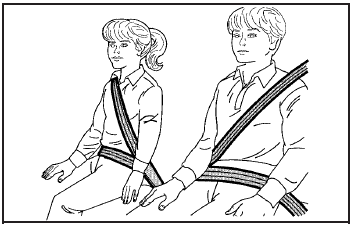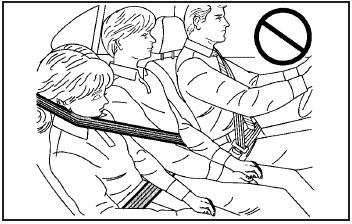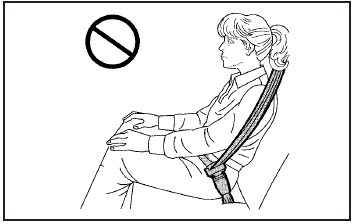Older Children

Older children who have outgrown booster seats should wear the vehicleŌĆÖs safety belts.
The manufacturerŌĆÖs instructions that come with the booster seat, state the weight and height limitations for that booster. Use a booster seat with a lap-shoulder belt until the child passes the below fit test:
ŌĆó Sit all the way back on the seat. Do the knees bend at the seat edge? If yes, continue. If no, return to the booster seat.
ŌĆó Buckle the lap-shoulder belt. Does the shoulder belt rest on the shoulder? If yes, continue. If no, try using the rear safety belt comfort guide. See ŌĆ£Rear Safety Belt Comfort GuidesŌĆØ under Lap-Shoulder Belt for more information. If the shoulder belt still does not rest on the shoulder, then return to the booster seat.
ŌĆó Does the lap belt fit low and snug on the hips, touching the thighs? If yes, continue. If no, return to the booster seat.
ŌĆó Can proper safety belt fit be maintained for length of trip? If yes, continue. If no, return to the booster seat.
If you have the choice, a child should sit in a position with a lap-shoulder belt and get the additional restraint a shoulder belt can provide.
Q: What is the proper way to wear safety belts?
A: An older child should wear a lap-shoulder belt and get the additional restraint a shoulder belt can provide. The shoulder belt should not cross the face or neck. The lap belt should fit snugly below the hips, just touching the top of the thighs. This applies belt force to the childŌĆÖs pelvic bones in a crash. It should never be worn over the abdomen, which could cause severe or even fatal internal injuries in a crash.
Also see ŌĆ£Rear Safety Belt Comfort GuidesŌĆØ under Lap-Shoulder Belt.
According to accident statistics, children and infants are safer when properly restrained in the rear seating positions than in the front seating positions.
In a crash, children who are not buckled up can strike other people who are buckled up, or can be thrown out of the vehicle. Older children need to use safety belts properly.
WARNING:
Never do this.
Never allow two children to wear the same safety
belt. The safety belt can not properly spread the
impact forces. In a crash, the two children can be
crushed together and seriously injured. A safety
belt must be used by only one person at a time.

WARNING:
Never do this.
Never allow a child to wear the safety belt with the
shoulder belt behind their back. A child can be
seriously injured by not wearing the lap-shoulder
belt properly. In a crash, the child would not be
restrained by the shoulder belt. The child could
move too far forward increasing the chance of
head and neck injury. The child might also slide
under the lap belt. The belt force would then be
applied right on the abdomen. That could cause
serious or fatal injuries. The shoulder belt should
go over the shoulder and across the chest.

See also:
Using the Re-dial Command
1. Press and hold for two
seconds. The system
responds with ŌĆ£ReadyŌĆØ followed by a tone.
2. After the tone, say ŌĆ£Re-dialŌĆØ. The system responds
with ŌĆ£Re-dial using <phone name>ŌĆ ...
Lower Anchors and Tethers for
Children (LATCH)
The LATCH system holds a child restraint during driving
or in a crash. This system is designed to make
installation of a child restraint easier. The LATCH
system uses anchors in the vehicle and ...
Auto Rear Defog
If equipped, this will allow you to
turn the auto rear defog on or off.
This feature will automatically turn
on the rear defogger when it is cold
outside.
Press SELECT when Auto Rear
Defog i ...


